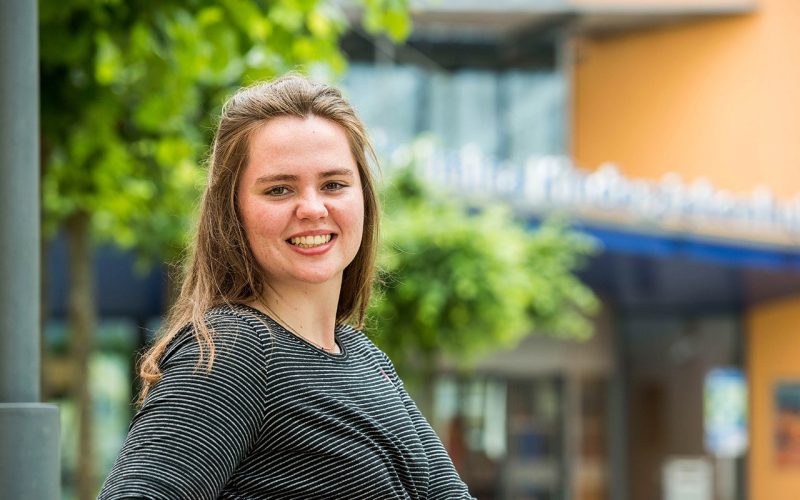From 0 to 18, Wilma (21) was under treatment at the Wilhelmina Children’s Hospital (WKZ) for her congenital heart defect. She has since stopped taking medication and her blood pressure is normal. ‘Anatomically healthy,’ her doctor calls it. But Wilma didn’t say goodbye to the WKZ. She wanted to give something back. “I really like the kindness of the staff. When I myself was admitted to nursing ward lion as a child, I couldn’t sleep at night. A nurse stayed with me to talk. Special how they take time for you, even if they are very busy. I want to give that to a new batch of patients as well.” Wilma has now finished her studies and, after an internship at the WKZ, works as a staff secretary for pediatric pulmonary diseases.
At my birth in the hospital in Wageningen, everything still seemed fine. Also at the regular check-ups at the child health center and at the family doctor’s office, everything was okay. When I was three weeks old, my mother noticed that I often had cold feet and hands and ate badly. The family doctor thought nothing was wrong. But my mother didn’t trust it. Thanks to her motherly feeling, my heart was listened to at the consultation center. Less than fifteen minutes later I was rushed by ambulance to Utrecht.
In the WKZ the doctors discovered that I had a hole between my left and right ventricle. This is what they call VSD, Ventricular Septum Defect. But there was more, there was also a narrowing in my aortic arch. That combination made my heart condition complex, hence the emergency admission. Soon I had open heart surgery, I was just one month old. My heart was the size of a walnut.
I think it was much more intense for my parents than for me. My first memories of the hospital are only from when I was six or seven years old. Then I had grown enough and a stent was placed in my aorta to widen the narrowing. With that stent, things went very well. I had no symptoms or restrictions at all and could do whatever I wanted. That’s why I had an active life from a young age. Just going to school, shopping with girlfriends, hip hop dancing and playing the trumpet. Especially when I look at other children with congenital heart defects, I notice that I was very lucky.”
In the years that followed, there were two more dotter treatments to pump up the stent a bit to make it bigger. Three years ago I had my last keyhole surgery to see how things were going. I was then 18 years old, so that was the time to transfer from the Center for Congenital Heart Defects at the WKZ to the center for (young) adults with congenital heart defects at the UMC Utrecht. There, Dr. Meijboom came to the WKZ to get acquainted and then my pediatric cardiologist, Dr. Molenschot, transferred me to him. What a shame! In the WKZ I knew everyone. Now I only come to UMC Utrecht for check-ups once every two years, so I don’t see much of Dr. Meijboom. Of course that’s great news, because I no longer take any medication and my blood pressure is normal.
In the meantime I have graduated. During my studies I did an internship at the WKZ as a secretary. Because of my congenital heart defect, I had been coming to the WKZ for so long, I knew a lot of people there. That’s how I got an internship. Because you have a white coat on, children automatically think you are the doctor. “Are you going to poke?” is often their first fear.
There is close cooperation between the center for congenital heart defects for children at the WKZ and the center for (young) adults at the UMC Utrecht. We are now even working on a joint center that will bring together outpatient care for all ages at the WKZ. I think that’s a very good development. After all, as a heart patient you need to be monitored and guided throughout your life. For example, the development of my aortic arch had to be monitored very closely while I was still growing. But it is also important to monitor what symptoms develop later in life as a result of the heart defects. From one joint center, doctors can consult each other even better, exchange knowledge and follow patients. And the transition to an adult cardiologist when you are eighteen is also less significant.
“Wilma was treated well at a young age and the results for her are very good. Nevertheless, it is important that we continue to see patients like her for regular check-ups as they mature. Children with a congenital heart defect are somewhat more likely to have problems again later on. Such as high blood pressure, impaired function of the left ventricle or an arrhythmia. An arrhythmia causes acute symptoms. But other problems develop so slowly that you hardly notice it. By monitoring their long-term health, we can spot any developing problems before they become symptoms. Early intervention then prevents bigger problems. Intervention is not only with heart surgery, or intervention with a catheter, but also with medication. Lifestyle advice is sometimes also useful and necessary, because healthy living helps. Through good cooperation between the “pediatric team” and the “adult team,” we try to ensure continuity of care for patients with congenital heart defects, and if another intervention is ever needed again, we discuss it together and we do it together.
